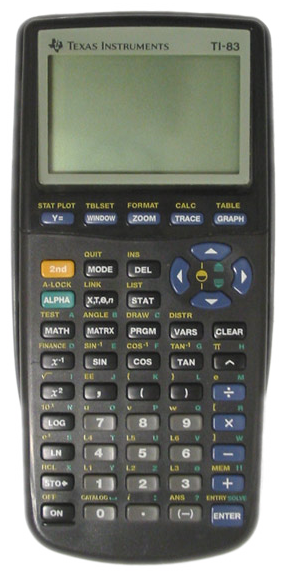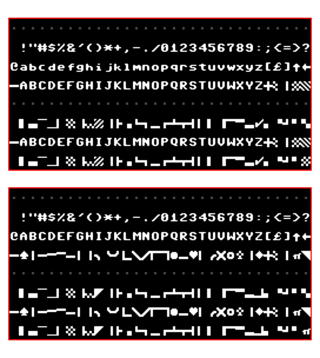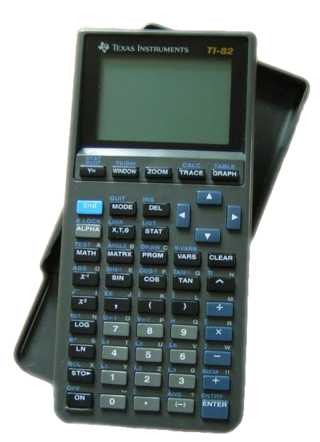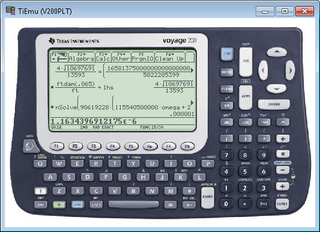
The TI-89 and the TI-89 Titanium are graphing calculators developed by Texas Instruments (TI). They are differentiated from most other TI graphing calculators by their computer algebra system, which allows symbolic manipulation of algebraic expressions—equations can be solved in terms of variables, whereas the TI-83/84 series can only give a numeric result.

A graphing calculator is a handheld computer that is capable of plotting graphs, solving simultaneous equations, and performing other tasks with variables. Most popular graphing calculators are programmable calculators, allowing the user to create customized programs, typically for scientific, engineering or education applications. They have large screens that display several lines of text and calculations.

The TI-83 series is a series of graphing calculators manufactured by Texas Instruments.

PETSCII, also known as CBM ASCII, is the character set used in Commodore Business Machines' 8-bit home computers.

The TI-85 is a graphing calculator made by Texas Instruments based on the Zilog Z80 microprocessor. Designed in 1992 as TI's second graphing calculator, it was replaced by the TI-86, which has also been discontinued.

The TI-84 Plus is a graphing calculator made by Texas Instruments which was released in early 2004. There is no original TI-84, only the TI-84 Plus, the TI-84 Plus Silver Edition models, and the TI-84 Plus CE. The TI-84 Plus is an enhanced version of the TI-83 Plus. The key-by-key correspondence is relatively the same, but the TI-84 features improved hardware. The archive (ROM) is about 3 times as large, and the CPU is about 2.5 times as fast. A USB port and built-in clock functionality were also added. The USB port on the TI-84 Plus series is USB On-The-Go compliant, similar to the next generation TI-Nspire calculator, which supports connecting to USB based data collection devices and probes, and supports device to device transfers over USB rather than over the serial link port.

The TI-82 is a graphing calculator made by Texas Instruments. The TI-82 was designed in 1993 as a stripped down, more user friendly version of the TI-85, and as a replacement for the TI-81. It was the direct predecessor of the TI-83. It shares with the TI-85 a 6 MHz Zilog Z80 microprocessor. Like the TI-81, the TI-82 features a 96×64 pixel display, and the core feature set of the TI-81 with many new features.

The TI-81 was the first graphing calculator made by Texas Instruments. It was designed in 1990 for use in algebra and precalculus courses. Since its release, it has been superseded by a series of newer calculators: the TI-85, TI-82, TI-83, TI-86, TI-83 Plus, TI-83 Plus Silver Edition, TI-84 Plus, TI-84 Plus Silver Edition, TI-84 Plus C Silver Edition, TI-Nspire, TI-Nspire CAS, TI-84 Plus CE, and most recently, the TI-84 Plus CE Python. Most of them share the original feature set and 96×64-pixel display that began with this calculator, with the exceptions of the TI-84 Plus C Silver Edition and the TI-84 Plus CE family.
TI-BASIC is the official name of a BASIC-like language built into Texas Instruments (TI)'s graphing calculators. TI-BASIC is a language family of three different and incompatible versions, released on different products:

The TI 73 series is a series of graphing calculators made by Texas Instruments, all of which have identical hardware.
Programmable calculators are calculators that can automatically carry out a sequence of operations under control of a stored program. Most are Turing complete, and, as such, are theoretically general-purpose computers. However, their user interfaces and programming environments are specifically tailored to make performing small-scale numerical computations convenient, rather than general-purpose use.

TiEmu is an emulator that works on many different operating systems like Linux/Unix, macOS, FreeBSD, Microsoft Windows and so on. It emulates the Motorola 68000 series Texas Instruments graphing calculators. TiEmu is licensed under the GPL.
Virtual TI, or "VTI," is a feature-rich graphing calculator emulator for Microsoft Windows, written in C++ by Rusty Wagner. It features a graphical debugger, a grayscale display, data transfer between computer and emulated calculator, black-link, parallel link and more.

The TI-Nspire is a graphing calculator line made by Texas Instruments, with the first version released on 25 September 2007. The calculators feature a non-QWERTY keyboard and a different key-by-key layout than Texas Instruments's previous flagship calculators such as the TI-89 series.
On graphing calculators, an assembly shell is a program that is used to run other programs written in the calculator's native machine code rather than the calculator's standard high-level programming language. While all assembly shells can run assembly programs, some can also run high-level programs. For example, MirageOS and DoorsCS, two popular TI-83+ assembly shells, can run TI-BASIC programs by placing a colon as the first bit of code on the first line in the program.

The Texas Instruments signing key controversy resulted from Texas Instruments' (TI) response to a project to factorize the 512-bit RSA cryptographic keys needed to write custom firmware to TI devices.

The ZX Spectrum character set is the variant of ASCII used in the ZX Spectrum family computers. It is based on ASCII-1967 but the characters ^, ` and DEL are replaced with ↑, £ and ©. It also differs in its use of the C0 control codes other than the common BS and CR, and it makes use of the 128 high-bit characters beyond the ASCII range. The ZX Spectrum's main set of printable characters and system font are also used by the Jupiter Ace computer.
Cemetech is a programming and hardware development group and developer community founded in 2000. Its primary software focus is calculator programming for TI and Casio graphing calculators, and its primary hardware focus is on mobile and wearable computing hardware. Among its most notable projects are the Doors CS shell for the TI-83+ series of graphing calculators, the Clove 2 dataglove, the Ultimate Calculator, and the CALCnet / globalCALCnet system for networking graphing calculators and connecting them to the Internet. The Cemetech website hosts tools for calculator programmers, including the SourceCoder TI-BASIC IDE and the jsTIfied TI-83+/84+ emulator. The founder of the site, Dr. Christopher Mitchell, began the site to showcase his personal projects, but since its early days, it has branched out to become one of the several major sites of the TI calculator hobbyist community and a source for hardware and programming development assistance. It has incubated many software and hardware projects beginning in the calculator community at its roots but including microprocessor development, general electrical engineering, desktop applications, and mobile/web applications.
The RPL character set is an 8-bit character set and encoding used by most RPL calculators manufactured by Hewlett-Packard as well as by the HP 82240B thermo printer. It is sometimes referred to simply as "ECMA-94" in documentation, although it is for the most part a superset of ISO/IEC 8859-1 / ECMA-94 in terms of printable characters, and it differs from ISO/IEC 8859-1 by using displayable characters rather than control characters in the 0x80 to 0x9F range of code points.

TI-BASIC 83,TI-BASIC Z80 or simply TI-BASIC, is the built-in programming language for the Texas Instruments programmable calculators in the TI-83 series. Calculators that implement TI-BASIC have a built in editor for writing programs. While the considerably faster Z80 assembly language is supported for the calculators, TI-BASIC's in-calculator editor and more user friendly syntax make it easier to use. TI-BASIC is interpreted.












